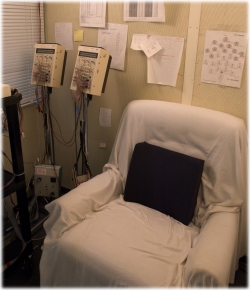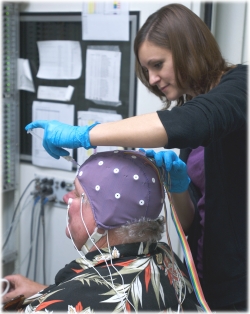What happens in a brain wave study?
What to expect
 When you first come in, you are asked to sign a
consent form that outlines
what you can expect as a research subject and states your
bill of rights.
You will also be asked to fill out a handedness
questionnaire which asks which hand you use to perform certain tasks
like writing or throwing, and a voluntary questionnaire which asks
about medications and neurological history.
When you first come in, you are asked to sign a
consent form that outlines
what you can expect as a research subject and states your
bill of rights.
You will also be asked to fill out a handedness
questionnaire which asks which hand you use to perform certain tasks
like writing or throwing, and a voluntary questionnaire which asks
about medications and neurological history.
Getting the cap and electrodes on takes about a half hour to an hour. Usually there are some practice trials so you can get the feel of the task. The length of the actual experimental run ranges from 40 to 90 minutes. Sometimes the session is split between two days to reduce the amount of time you're in the chair.
There are regularly scheduled breaks. You may ask for a break whenever you want. You can walk out of the experiment whenever you want.
The Cap
 In order for the computer to record your brain waves, you wear a
skull cap which has a number of electrodes sewn in. Each electrode
is at the top of a little plastic well, so it doesn't contact your
scalp. Some electrolytic gel is squirted into the well to make a
conductive bridge between scalp and electrode. The gel looks like
something you could get at a supermarket, except that it isn't
greasy or sticky. It washes out with water.
In order for the computer to record your brain waves, you wear a
skull cap which has a number of electrodes sewn in. Each electrode
is at the top of a little plastic well, so it doesn't contact your
scalp. Some electrolytic gel is squirted into the well to make a
conductive bridge between scalp and electrode. The gel looks like
something you could get at a supermarket, except that it isn't
greasy or sticky. It washes out with water.
The cap also has a strap which fastens under the chin and keeps the cap from moving around.
There are two other electrodes, each of which is placed behind an ear. They serve as references for the cap electrodes. The remaining few electrodes are mounted near your eyes with tape.